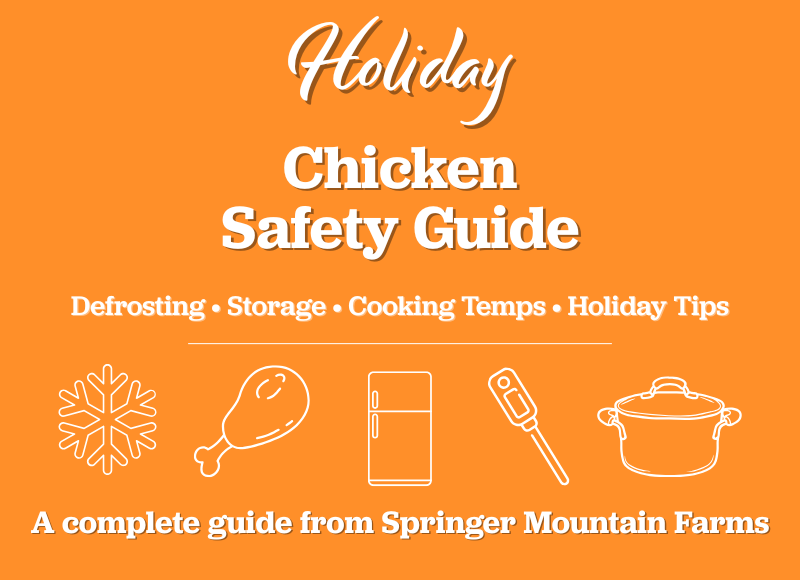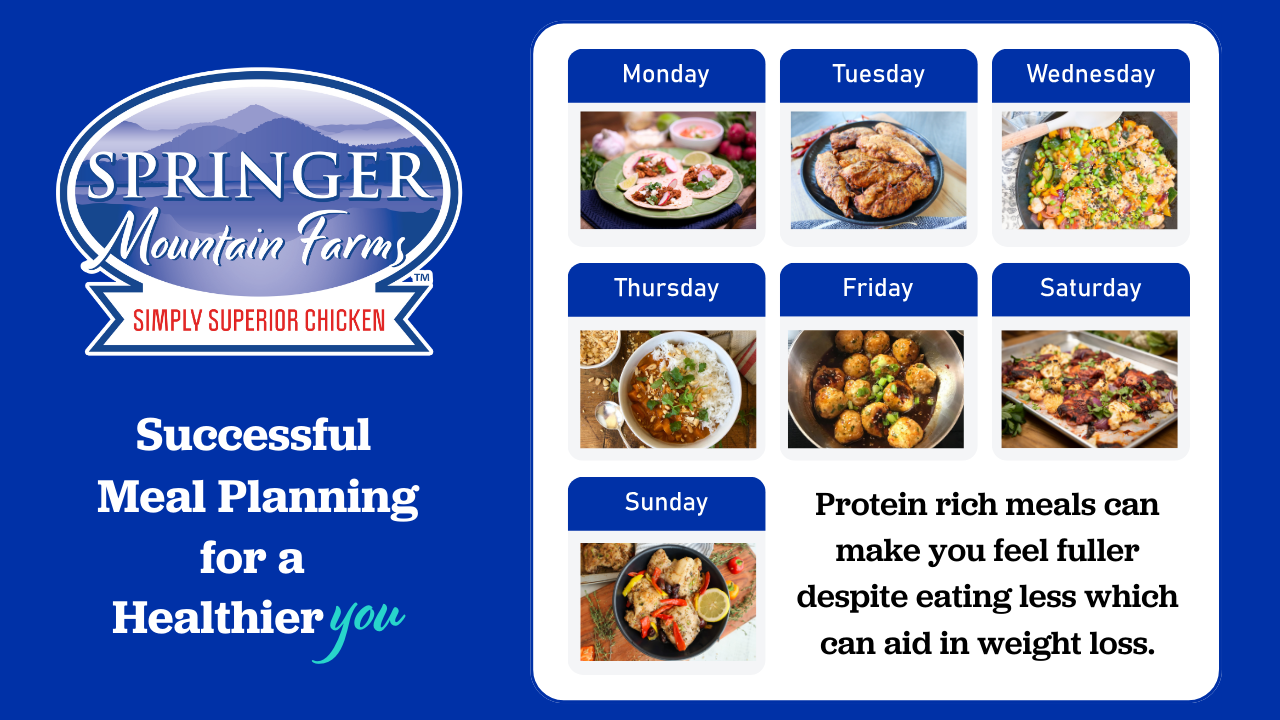🍗 Holiday Chicken Guide: How to Defrost, Store & Cook Chicken Safely and Deliciously
Whether you’re roasting a whole chicken for Thanksgiving or prepping make-ahead dishes for family gatherings, proper handling and cooking make all the difference. This holiday chicken guide brings together food-safety best practices from USDA recommendations to help you defrost, store, and cook chicken with confidence this season.
❄️ How to Properly Defrost Chicken
Safe thawing is the first step toward a successful holiday dish.
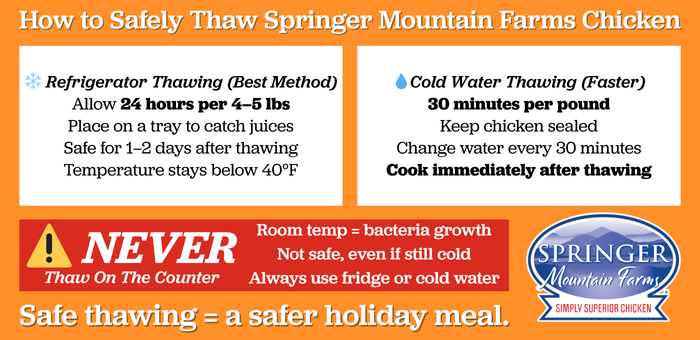
🧊 Refrigerator Thawing (Recommended)
-
Allow 24 hours per 4–5 pounds of chicken.
-
Place the packaged chicken on a tray or in a bowl to catch any juices.
-
Once thawed, the chicken can be safely kept in the fridge for 1–2 more days before cooking.
💧 Cold Water Thawing (Faster Option)
-
Plan for 30 minutes per pound, changing the water every 30 minutes.
-
Keep chicken sealed in a leak-proof bag.
-
Cook immediately after thawing; do not refreeze.
🚫 Avoid Countertop Thawing
Room-temperature thawing allows bacteria to grow rapidly — even if the chicken still feels cold. Always use the refrigerator or cold-water method.
🧺 How to Store Chicken Before & After Cooking
Proper storage maintains quality and protects against contamination.
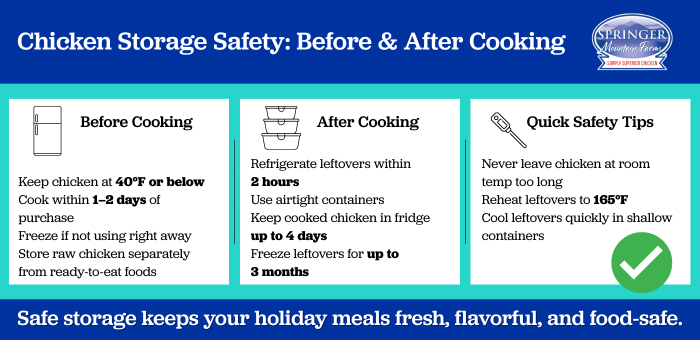
🥶 Before Cooking
-
Keep raw chicken refrigerated at 40°F or below.
-
If not cooking within 1–2 days, freeze immediately.
-
Store raw chicken separately from ready-to-eat foods.
🍗 After Cooking
-
Refrigerate leftovers within 2 hours (1 hour if above 90°F).
-
Store cooked chicken in airtight containers for up to 4 days.
-
Freeze leftovers for up to 3 months for soups, hashes, and casseroles.
🥄 Should You Stuff a Chicken for the Holidays?
Stuffing a whole chicken may feel traditional, but for food-safety reasons, it’s best avoided.
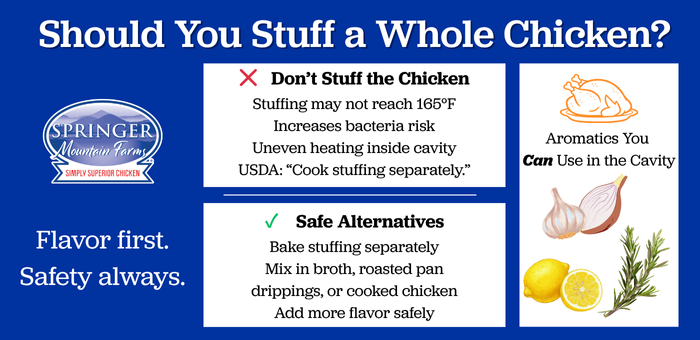
🛑 Recommended: Do Not Stuff the Chicken
USDA guidance strongly recommends not stuffing poultry before roasting.
Why?
-
The stuffing often does not reach 165°F, even when the chicken is fully cooked.
-
This temperature gap can allow harmful bacteria to survive inside the cavity.
-
Because whole chickens are smaller than turkeys, the cavity heats unevenly, increasing the risk.
✔️ A Safer Alternative
Bake stuffing separately and add rich chicken flavor by mixing in:
-
Pan drippings
-
Shredded cooked chicken
-
Homemade stock
This gives you all the holiday flavor with none of the safety concerns.
🍋 Add Aromatics Instead
For moisture and aroma, place these inside the cavity (safe and recommended):
-
Lemon halves
-
Onion wedges
-
Garlic cloves
-
Fresh rosemary, thyme, or sage
These add beautiful flavor without affecting cook time or safety.
🔥 Best Methods for Cooking Chicken During the Holidays
Great cooking technique guarantees perfect results every time.
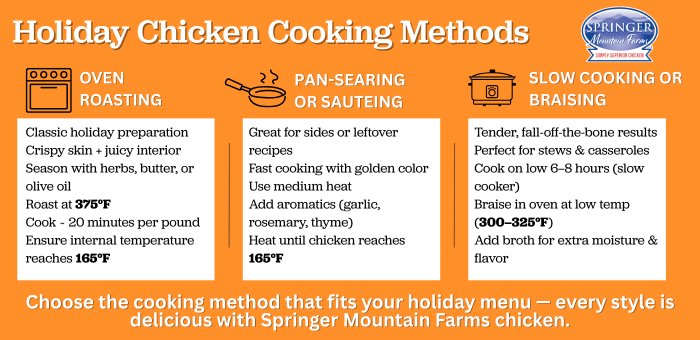
🏠 Oven Roasting (Whole Young Chicken)
- Season with olive oil, melted butter, and herbs for a classic golden finish.
- Roast at 375°F for about 20 minutes per pound, or until the thickest part of the breast and thigh reaches 165°F.
-
Use a food thermometer — never guess doneness.
-
Let rest 10–15 minutes before carving to lock in juices.
🍳 Pan Searing or Sautéing
Ideal for side dishes, leftover recipes, or breakfast skillets. Heat until the chicken reaches 165°F and develops a golden crust.
🍲 Slow Cooking or Braising
Perfect for cozy stews and casseroles. Slow-cook on low for 6–8 hours or braise in the oven until tender and pull-apart.
🧂 Springer Mountain Farms Holiday Cooking Tips
-
Don’t rinse raw poultry — this spreads bacteria around the kitchen.
-
Follow the two-hour rule for perishable foods.
-
Save roasted drippings for gravy or homemade stock.
-
Pair your chicken with festive sides like roasted vegetables, cornbread dressing, or garlic mashed potatoes.
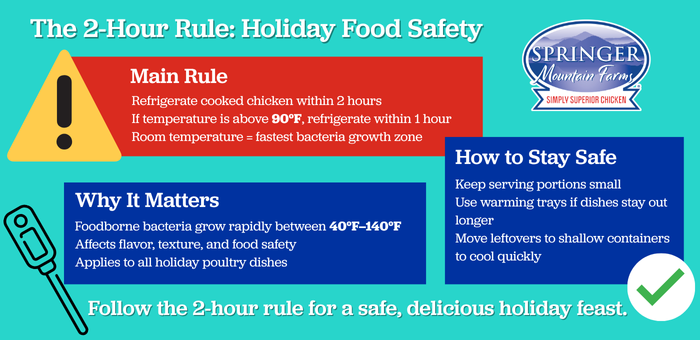
🎉 Make Chicken the Star of Your Holiday Table
This Thanksgiving and Christmas season, enjoy a meal that’s flavorful, safe, and stress-free. With Springer Mountain Farms chicken, you’re choosing a quality brand of chicken you can trust — raised with care and delicious in every recipe. From thawing to carving, these holiday cooking tips ensure your meal is memorable, wholesome, and absolutely delicious.
Find holiday cooking inspiration and create new holiday traditions with chicken as your table centerpiece:
Why Choose Chicken For Thanksgiving This Year?
